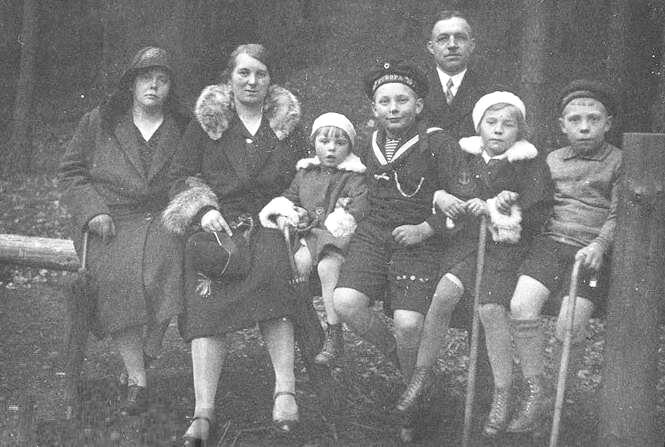
German Hosiery Varitions: The 1930s

Figure 1.--This family snapshot is undated, but looks to have been taen in the earkly-1930s. The children ear a range of hosiery. The boys wear kmnee socks. The younger girl wearsankle socks which were not all that common. The older girl wears long stockings. Th children look to be about 3-10 years old.
|
|
Here there were variations from family to family, although we also see variations within the same family. We do not fully understand the variations. We think they were in part seasonl with chikldren having both long stockings and knee socks. Ankle siocks were less common. There were no written rules about such matters. There were popular conventions, but we see condiderable variation from family to family. This included both on what was purchased for the childen as well as to the degre mother decided as toallowing the childen to dcide what was worn. And the children as they go older did have preferences. You can see that in the photographic record. We seea lot of children, both boys and girls, in the 1930s rolling down their stockings especially during the summer. Social class may have been a factor. We think that long stockings may have been more common with working-class families. But we are not entirely sure about this. The variations were often, but not aslways age bassed. It became increasingly less common for older boys to wear long stockings, especially by the late 1930s. Kneesocks gradually were more popular with older boys, but they might wear knickers rather than shorts during the winter. We do not commonly see ankle socks, but we are not etirely sure what kind of hosiery older boys wearing long pants had. We see very little disctive variation based on gender, at least for pre-teen school children boh boys and gurls wore long stockings. The only difference we can see is that white long stockings seem more popular for the girls. We do see boys wearing white knee ocks, but jite long stockings were more common. Basically we see children commonly wearing both knee socks and long stockings. Beginning with the teen years, long stiockings begin to be less popular with the boys. We do see teenage guirls continuing to wear long sockings. Seasonality was another factor in the selection of hosiery. It may well have been thevmajor fctor, at least with younger childen. We see long stockings being worn much more commonly during the winter.
Family Variation
There were no written rules about such matters. There were popular conventions, but we see condiderable variation from family to family. This included both on what was purchased for the childen as well as to the degre mother decided as toallowing the childen to dcide what was worn. And the children as they go older did have preferences. You can ee that in the photographic record. We see a lot of children, both boys and girls, in the 1930s rolling down their stockings especially during the summer. Social class may have been a factor. We think that long stockings may have been more common with working-class families. But we are not entirely sure about this.
Social Class
Social class may have been a factor. We think that long stockings may have been more common with
working-class families. But we are not entirely sure about this.
Age
The variations were often, but not aslways age bassed. It became increasingly less common for older boys to wear long stockings, especially by the late 1930s. Kneesocks gradually were more popular with older boys, but they might wear knickers rather than shorts during the winter. We do not commonly see ankle socks, but we are not etirely sure what kind of hosiery older boys wearing long pants had.
Gender
We see very little disctive variation based on gender, at least for pre-teen school children boh boys and gurls wore long stockings. The only difference we can see is that white long stockings seem more popular for the girls. We do see boys wearing white knee ocks, but jite long stockings were more common. Basically we see children commonly wearing both knee socks and long stockings. Beginning with the teen years, long stiockings begin to be less popular with the boys. We do see teenage guirls continuing to wear long sockings.
Seasonality
Seasonality was another factor in the selection of hosiery. It may well have been thevmajor fctor, at least with younger children. We see long stockings being worn much more commonly during the winter.
HBC

Navigate the Boys' Historical Clothing German pages:
[Return to the Main German 1930s hosiery page]
Return to the Main German hosiery 20th century chronology page]
[Return to the Main German hosiery chronology page]
[German choirs]
[German movies]
[German royalty]
[German school uniforms]
[German youth groups]
[German sailor suits]
[Lederhosen]
[Ethnic]
[Tights]
[Long stockings]
Navigate the Boys' Historical Clothing Web Site:
[Introduction]
[Activities]
[Biographies]
[Chronology]
[Clothing styles]
[Countries]
[Bibliographies]
[Contributions]
[FAQs]
[German glossary]
[Images]
[Links]
[Registration]
[Tools]
[Boys' Clothing Home]
Created: 5:44 AM 10/30/2012
Last updated: 5:44 AM 10/30/2012



